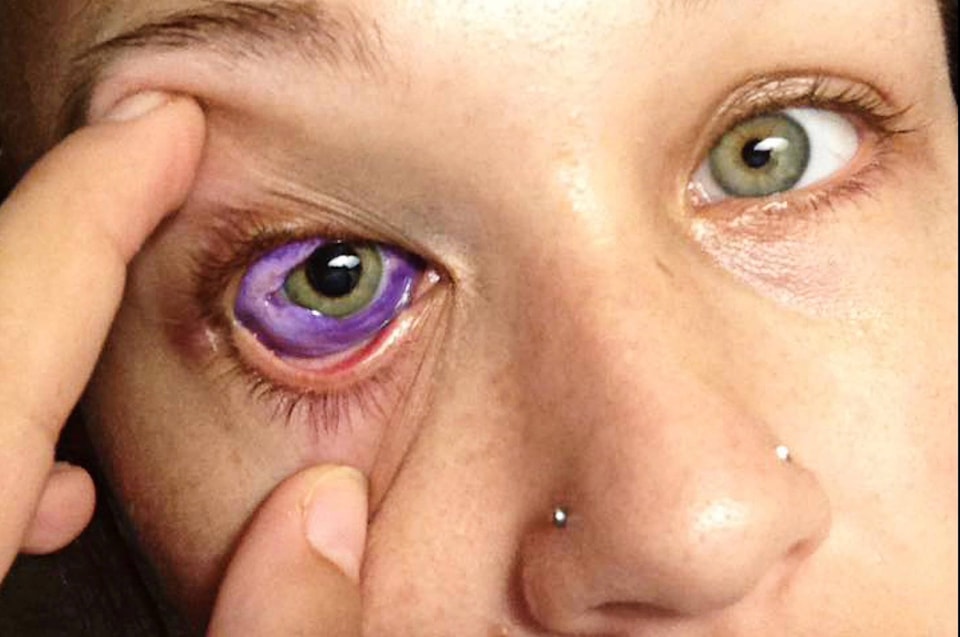WARNING: This story contains graphic content. Discretion is advised.
Medical professionals and body artists say the practice of tattooing the eyeball, which recently left an Ottawa woman facing the prospect of vision loss, is on the rise despite its many risks.
Ophthalmologists and tattoo studios decry the practice, saying it’s very difficult to engage in it safely.
Nonetheless, they say they hear of increasing demand for the extreme form of body modification which involves injecting ink into the whites of the eyes.
A 24-year-old alternative model says she has learned the hard way about the risks of the procedure.
Catt Gallinger says she recently allowed someone to dye the white of her right eye purple, but has since developed major complications.
Gallinger has currently lost part of the vision in the swollen, misshapen eye and is facing the prospect of living with irreversible damage.
“This is a very big toll on the mental health,” she said in a telephone interview. “At this point, every day is different. Some days I feel a bit better, other days I kind of want to give up.”
Gallinger said she has long had an interest in body modification, and especially in tattooing the white of her eye, technically known as the sclera. But she said she took the plunge without doing adequate research on the procedure.
Had she done so, medical and tattoo professionals say she could have found a plethora of evidence discouraging the practice which has gained traction among body modification enthusiasts in recent years.
Ottawa-based ophthalmologist Dr. Setareh Ziai said she first heard of sclera tattoos as a rare phenomenon about a decade ago, but said she now learns of cases across Canada on a monthly basis.
Although ophthalmologists do occasionally use tattoo ink for medical purposes, such as to reduce glare or corneal scarring, she said the type of process Gallinger underwent bears little resemblance to those approved by the medical profession.
Ophthalmologists using ink inject it into the cornea in operating rooms using sterile equipment, Ziai said, adding most scleral tattoos are administered using an everyday syringe injecting the ink under the conjunctiva.
The area under the conjunctiva contains blood vessels, she said, meaning the ink can be carried throughout the eye and pose a greater risk to the organ. Immediate consequences of the injection can include blindness, while longer-term effects may include cataracts and severe infection, she said.
Most alarming of all, Ziai said, is the fact that researchers do not yet have a handle on the long-term impact of such a procedure.
“What’s going to happen when these dyes migrate to different parts of the eyeball or different parts of the body?” she asked. “Are there risks related to cancer? Persistent inflammation? We have no idea. So even if you really like what you look like and the procedure went perfectly well, we don’t know what’s going to happen three, five, 10 years down the road.”
Many tattoo artists are similarly leery of the practice, according to one Toronto studio owner.
David Glantz of Archive Tattoo Studio said he knows of very few that offer scleral tattoos despite the growing fascination with the procedure he’s observed online.
He said insurance companies will not cover studios that provide scleral tattoos, adding that no licensed training is currently offered for the procedure.
“No tattooer I know would offer it. Most of us have a conscience, would like to keep our jobs, and keep making cool tattoos in whatever style we choose to work in,” Glantz said in an email. “There’d be no point to any of us jeopardizing our careers for a ‘wow, one or both of you are really daring or stupid,’ kind of story. It’s not the kind of bragging most of us are in this trade for.”
Gallinger said she hopes to see the practice become regulated and performed by highly qualified professionals.
“I would never recommend anyone get it done until it becomes something that is a cosmetic procedure done by surgeons,” she said. “I’m hoping that that will happen, because people are going to do this either way.”
Michelle McQuigge, The Canadian Press



